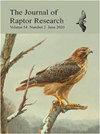猛禽保护的快速种群评估:亚成虫、飞蚊、稻草人和环境。对亨特和劳的回应
IF 1.2
4区 生物学
Q2 ORNITHOLOGY
引用次数: 0
摘要
许多迅猛龙表现出的生活史特征,包括繁殖迟缓、寿命长、年繁殖力低和季节性活动大,同时使它们面临保护风险,也使它们难以研究。开发快速评估猛禽种群的有效方法将提高适应性管理的可行性和及时性。为此,我们使用了一个阶段结构的人口统计学模型来评估两种人口结构测量方法提供的人口下降风险洞察:亚成虫巢穴占用率和非领土“漂浮”成虫与领土繁殖者的比例(Monzón和Friedenberg 2018)。在这里,我们回应亨特和劳(2023)的一篇评论,该评论涉及我们的研究前提。毫无疑问,这些指标需要进一步的背景来进行诊断;然而,亨特和劳(2023)对我们的研究提出了三个具体的批评,称他们为稻草人。虽然我们并不打算这样做,但在这里讨论每一个批评都提供了一个机会来澄清这些人口统计指标是如何解释的。首先,Hunt和Law(2023)断言,我们提出,作为一个稻草人,亚成虫的巢穴占用只有一种可能的解释。他们指的是我们对先前发表的工作的总结,这些工作表明“巢穴中亚成虫的高发生率可能是种群数量下降或下降的高风险特征,因为它可能耗尽了成年繁殖者和飞蚊”(Monzón和Friedenberg 2018,引用balbontturn等人2003和Ferrer等人2003)。我们的摘要反映了这方面研究的优势。即使是亨特和劳(2023),在指出我们的总结的狭隘性之后不久,也确定了猛禽中亚成虫筑巢的普遍罕见性,并断言即使在低水平上观察到,也应将其视为有意义的警告信号。以这一假设为前提,我们探索了各种可能产生高亚成虫巢占用率的生态情景,然后评估了这一快照指标在指示种群下降风险方面的价值。该指标本身对于识别中度下降风险的情景有用,但无法识别低风险和高风险的情况(Monzón和Friedenberg 2018)。Hunt和Law(2023)提出的例子都提供了额外的生态背景,可以适当地解释这一指标,并分享成人高死亡率是一个重要因素的主题——这是我们在原始研究中得出的确切结论(Monzón和Friedenberg 2018)。在加州Altamont Pass风力资源区的金鹰(Aquila chrysaetos)的例子中,亚成虫巢穴的高比例被解释为与风力涡轮机碰撞导致的高成虫死亡率(Wiens and Kolar 2021)。类似地,本文章由计算机程序翻译,如有差异,请以英文原文为准。
Toward Rapid Population Assessment for Raptor Conservation: Subadults, Floaters, Strawmen, and Context. A Response to Hunt and Law
Many raptors exhibit life history characteristics that simultaneously place them at conservation risk and make them difficult to study, including delayed reproduction, long life spans, low annual fecundity, and large seasonal movements. Developing effective methods for rapid assessment of raptor populations will improve the feasibility and timeliness of adaptive management. To this end, we used a stage-structured demographic model to evaluate the insight into population decline risk provided by two population structure measurements: subadult nest occupancy and the ratio of non-territorial ‘‘floater’’ adults to territorial breeders (Monzón and Friedenberg 2018). Here, we respond to a commentary by Hunt and Law (2023) that addresses our study’s premises. There is no disagreement that the metrics require further context to be diagnostic; however, Hunt and Law (2023) offer three specific criticisms of our study, calling them strawmen. Although we did not intend them as such, discussing each criticism here offers an opportunity to clarify how these demographic metrics are and should be interpreted. First, Hunt and Law (2023) assert that we proposed, as a strawman, that subadult nest occupancy has only one possible explanation. They are referring to our summary of previously published work suggesting ‘‘a high incidence of subadults on nests might characterize a population in decline or at high risk of decline because it may be depleted of adult breeders and floaters’’ (Monzón and Friedenberg 2018, citing Balbontı́n et al. 2003 and Ferrer et al. 2003). Our summary reflects the preponderance of studies on the subject. Even Hunt and Law (2023), shortly after pointing out the narrowness of our summary, establish the general rarity of subadult nesting among raptors and assert that it should be regarded as a meaningful warning sign even if observed at a low level. With this premise as a hypothesis, we explored various ecological scenarios that can yield high rates of subadult nest occupancy and then assessed the value of this snapshot metric for indicating risk of population decline. The metric on its own was useful for identifying scenarios of moderate decline risk but failed to discern cases of low and high risk (Monzón and Friedenberg 2018). The examples presented by Hunt and Law (2023) all provide additional ecological context with which to interpret the metric properly and share the theme of high adult mortality being an important factor—the exact conclusion we reached in our original study (Monzón and Friedenberg 2018). In the example of Golden Eagles (Aquila chrysaetos) in the Altamont Pass Wind Resource Area in California, a high rate of subadult nest occupancy is interpreted in the context of high adult mortality from collisions with wind turbines (Wiens and Kolar 2021). Similarly, the
求助全文
通过发布文献求助,成功后即可免费获取论文全文。
去求助
来源期刊

Journal of Raptor Research
生物-鸟类学
CiteScore
2.30
自引率
17.60%
发文量
61
审稿时长
>12 weeks
期刊介绍:
The Journal of Raptor Research (JRR) is an international scientific journal dedicated entirely to the dissemination of information about birds of prey. Established in 1967, JRR has published peer-reviewed research on raptor ecology, behavior, life history, conservation, and techniques. JRR is available quarterly to members in electronic and paper format.
 求助内容:
求助内容: 应助结果提醒方式:
应助结果提醒方式:


